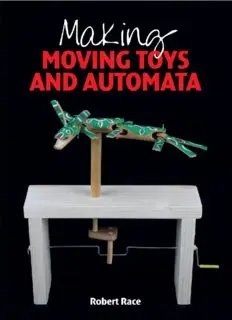
Making Moving Toys and Automata PDF
Preview Making Moving Toys and Automata
Making MOVING TOYS AND AUTOMATA Making MOVING TOYS AND AUTOMATA Robert Race THE CROWOOD PRESS First published in 2018 by The Crowood Press Ltd Ramsbury, Marlborough Wiltshire SN8 2HR www.crowood.com This e-book first published in 2018 © Robert Race 2018 All rights reserved. This e-book is copyright material and must not be copied, reproduced, transferred, distributed, leased, licensed or publicly performed or used in any way except as specifically permitted in writing by the publishers, as allowed under the terms and conditions under which it was purchased or as strictly permitted by applicable copyright law. Any unauthorised distribution or use of thistext may be a direct infringement of the author’s and publisher’s rights, and those responsible may be liable in law accordingly. British Library Cataloguing-in-Publication Data A catalogue record for this book is available from the British Library. ISBN 978 1 78500 492 6 All photographs are by the author unless stated otherwise. Frontispiece Cat and Spider. CONTENTS INTRODUCTION 1 BACK AND FORTH – Oscillating shafts 2 MAKING LINKS – Links and Linkages 3 PULLING STRINGS – Levers and fulcrums 4 SWINGING WEIGHTS – Balance and movement 5 TWISTING AND TURNING – Springs, shafts and cams 6 ROUND AND ABOUT – Momentum and control 7 IN THE WIND – Harnessing power INDEX INTRODUCTION This book is about designing and making small-scale automata. The emphasis is on using readily available materials, such as scraps of wood and wire, card and paper, bamboo, skewers, string, tinplate, and feathers. Of course, using the phrase ‘readily available’ does rather evade the issue; what is readily available will vary greatly according to circumstances. Many of the materials I use in my moving toys and automata are recycled or re-used, such as redundant packaging, off-cuts and driftwood. A jumping jack made by the author from a sardine can and a used paintbrush. Pulling the string makes the wooden limbs dance about. In the course of the book a number of simple mechanisms are explored, such as levers, linkages, cranks and cams. Also considered are ways of moving those mechanisms directly by hand, by springs or falling weights, and by the wind. In many places around the world there is a long tradition of using readily available materials and simple mechanisms to make moving toys. They may be made by parents for their children, or by the children themselves; they may be made by hand, using minimal resources, to sell on the street or at fairs and festivals; they may be the product of small- scale manufacture. Much of my own inspiration for making automata comes from a collection of such toys gathered over more than thirty years. Three paper windmills mounted with wires on a bamboo frame, from Dhaka, Bangladesh. The pattern I have followed in each chapter is to start simple, and to move, with occasional meanderings and diversions, to the design for an
